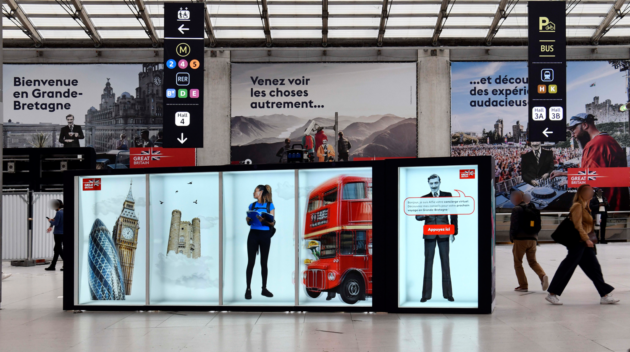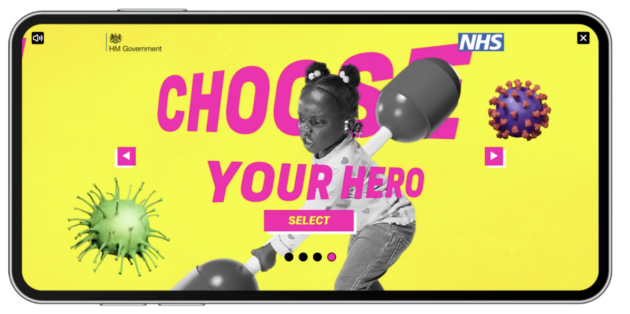Celebrating one year of Innovating with Impact!

This month marks the first anniversary of the government communications Innovating with Impact Strategy. It’s been a transformative year for government communications, with significant advances in how we connect with the public while maintaining ethical standards.
This is quite a significant milestone for us in government communications. Our strategy for innovating with impact set out an ambitious roadmap with one purpose: to harness new technologies and data in the areas that can drive the most impact, responsibly, and for public good.
We are thrilled to share some of the remarkable strides we’ve made, delivering results that have dramatically transformed not just how we work, but the real, meaningful difference we’re making in people’s lives through innovative communications.
Delivering on the Strategy’s ambitions
Over the past year, we’ve transformed commitments into concrete achievements across three main areas.
1. Empowering responsible innovation in government communications
Responsible use might not always sound like the shiniest part of innovation however, it’s the absolute ‘must’ first step. That’s why we successfully created and implemented the Framework for Ethical Innovation and Generative AI Policy across government departments, working closely with academic institutions and external agencies. The Framework provides a step-by-step approach for communicators to assess innovative approaches against our core values. The policy sets out clear principles for all government communicators to follow in their use of Generative AI.
Our guidance has also been recognised by many external stakeholders including Professor Emeritus Anne Gregory PhD at Huddersfield Business School, who said: “The GCS Innovating with Impact Strategy, Generative AI Policy and Ethical Framework for Innovation documents are some of the best I’ve seen. It’s clear GCS is a trail-blazer on this in the public sector globally. I do quite a lot of work in the AI space and what GCS does compares incredibly well. Most documents give guidance (the ‘what’), but not many go into detail on the ‘how’.”
When speaking with government communications members and senior leaders, they often express how empowered they feel to test bold new ideas because of our clear good practices and robust safeguards across government communications. This confidence has unlocked remarkable innovative work far and wide over the past year, even in traditionally high-risk areas. By establishing these guardrails, we’ve transformed how colleagues think about ethical considerations while embracing new technologies, driving more responsible and effective use of emerging tools throughout government.
2. Creating a culture of innovation across government communications through encouraging, identifying, testing and scaling innovative ideas
A core principle within government communications is continuous learning and improvement, as emphasised in the ‘Learning and Innovation’ section of our Evaluation Cycle. We’ve rigorously evaluated our innovation initiatives, measuring not just outputs but outcomes and broader impact. This approach has enabled us to identify valuable innovations, scale successful approaches across departments, improve less successful initiatives, and share learning systematically.
Research we carried out with government communicators showed that lack of access to a shared platform for knowledge sharing was a key barrier to innovation. In response, we launched our internal Community Forums in November last year, breaking down traditional silos and enabling faster knowledge transfer. Through this new service, we’ve established a dedicated and safe online space where government communicators can share case studies, ask questions, and discuss how they’ve overcome their innovation challenges. Both the Innovation and Assist forums are among the top five most followed forums, highlighting the value of this online space.
We now deliver comprehensive training on data literacy, AI applications, and emerging digital platforms, and a bespoke ‘AI for Communicators’ course. This important learning offer by our Academy ensures government communicators keep their AI skills and expertise up-to-date in a rapidly advancing climate. Similarly, our Test and Learn fund (the allocation of up to 10% of campaign budgets to test and scale innovative ideas) has embedded ‘permission’ to innovate by supporting several pioneering government campaigns over the last year.
As a culmination of all of the above interventions, we have some great cross-government examples of innovation in action.
VisitBritain’s 2024 Pre-Olympics ‘See Things Differently’ campaign invited French visitors to experience Britain as a unique and exciting destination. Building on VisitBritain’s ‘Spilling the Tea on GREAT Britain’ campaign, ‘See Things Differently’ aimed to boost spending in regional destinations and drive economic growth by inspiring the target audience to visit and explore more of Britain. VisitBritain’s popular generative AI-built character ‘Alfie’ acted as a concierge through an innovative 3D out-of-home holobox placement in Paris Gare du Nord, where French consumers could literally ‘Ask Alfie’ for off-the-beaten-track holiday tips.

This was supported by an augmented reality and interactive Snapchat filter, audio ads for Spotify, radio and podcast platforms personalised based on location and time of day voiced by Alfie, and a partnership campaign with TripAdvisor which drove 190% increase in booking intent.
Overall, the campaign successfully positioned Great Britain as an audacious and fun destination, resulting in 61.9 million impressions and generating awareness at 32% for the total audience (vs target of 24%) and a high of 44% awareness amongst the target audience of experience seekers (vs target of 33%). Scores for net consideration to visit were up by 9.3 percentage points (ppts). “Inspiring” and “Happy” were emotional statements that resonated the most amongst the audience with key messages of welcome, exciting experiences outside of London, and surprising experiences, being agreed with most.
NHS Blood and Transplant faced critical challenges meeting their daily requirement of voluntary blood donations due to appointment availability issues and high drop-off rates between people signing up and attending appointments to give blood. This was solved through an innovative data-driven approach which connected their internal appointment grid to automated advertising, targeting areas with highest appointment availability. The solution delivered impressive results, with Meta estimating a reduction in the cost per new donor of 12.5%, increasing bookings by up to 11.1% in larger cities, and ultimately enabling more life-saving blood donations.

Similar innovations in Health communications saw the Department for Health and Social Care (DHSC) continuing their innovative use of Audiomob’s non-intrusive audio ads in mobile games for their Winter Vaccines campaign. This offered campaign audiences an opt-in experience instead of forced video viewing. The innovative approach delivered exceptional results, with all eligible campaign audiences showing increased intention to get the flu and COVID-19 vaccines. Intention increased by 11 ppts among adults with a long-term health condition, 25 ppts amongst parents of two to three year-olds and 19 ppts among pregnant women.
Building on this success, the Department has partnered with Activision to deliver both in-game videos and a bespoke playable game, in which a mother/carer defeats the flu virus by using a pugil stick and vaccine power ups. This generated 1.5 million impressions, 6,261 clicks (0.39% CTR) and 1,512,844 Video Completes (96.90% view-through rate). The Department also partnered with Digital Turbine to deliver a playable end card after showing. This allowed players to choose their own vaccine hero and smash the virus to gain points and extra game bonuses. This led to 2.47 million impressions, 8,321 clicks and 2,409,183 video completes (97% view-through rate vs 90% benchmark).
These immersive and innovative examples demonstrate government communications commitment to adopting increasingly personalised comms for often life-saving campaigns.
3. Delivering new tools and platforms for the benefit of all government communicators
We’re extremely proud that our flagship AI-powered tool Assist is now fully live. It passed its final GDS Service Assessment to become the first cross-government generative AI tool to move from ‘beta’ to ‘live’ service – confirming it meets all government’s high security, accessibility and service standards.
Assist has over 4,600 users from 210 organisations, saving communicators on average three hours per week by assisting with brainstorming, drafting, reviewing and much more. We’ve also recently open-sourced the tool’s underlying code, to uphold transparency standards and support others building similar tools.
We will be setting out further ambitious plans to develop new cutting-edge capabilities in Assist to improve how we use our performance data, aligned to government missions and reaching our audiences as effectively as possible.
Building on the foundations of the Strategy
We’re proud of our progress but even more excited about future possibilities. Fundamentally, we need to continue to innovate within government communications if we are to be successful in:
- Acting on government missions
- Building trust with the public through communications
- Achieving increased efficiency and effectiveness as a profession.
We’ll continue our mission-led approach, supporting campaign teams to focus their efforts to test and scale new approaches in fewer, higher-priority areas. This is to ensure we have the greatest impact on these with our finite resources. For example, harnessing the increasingly real-time audience insight, targeting, and optimisation capabilities currently reshaping the digital marketing landscape, as well as delivering more tailored, relevant, and creative interactions between the public and government.
In line with the AI Opportunities Action Plan, we’re also looking outward to external expertise, working closely with agencies and the private sector to trial new technologies. This will be an ‘always-on’ approach we’ve evolved from the success of our Innovation Lab’s Project Spark! initiative, which saw the launch of our compelling Accessible by Default campaign last year in partnership with the Met Office.
Our renewed vision takes us beyond one-off innovation competitions like Project Spark! into a dynamic, always-on approach where brilliant ideas are quickly identified, rigorously evaluated, and rapidly implemented across all government communications. Some of these tests will fail, but what is important is that we embrace recoverable failure and be bold in trying new things!
We’re developing several exciting trials focused on these opportunities. Some we’ll deliver from the Cabinet Office, others we’ll need to partner with campaign teams across government to realise. Watch this space for opportunities to get involved.
We’re also updating our Generative AI policy and SAFE Framework to adapt to the changing communications landscape and evolving digital platforms. We’ll explore more sophisticated applications of AI and data analytics to deliver truly personalised communications that reach people where they are, increasing relevance while maintaining inclusivity.
Keeping pace with technological change
The pace of technological change has been remarkable since the launch of our Innovating with Impact Strategy. Generative AI has evolved significantly, with improved capabilities for content creation, data analysis, personalised communication and agentic workflows. Tools that were experimental a year ago are now sophisticated and integrated into our everyday work. Focus has shifted from simply adopting new technologies to implementing them thoughtfully and strategically.
This evolution mirrors our own journey in government communications, as we’ve moved from exploration to implementation across numerous government organisations and campaigns.
Innovation in government communication isn’t optional – it’s essential. By combining the diverse talents, experiences, and perspectives from our entire communications profession we can unlock the transformative potential before us, and reimagine what’s possible when we collaborate without boundaries. Let’s learn from what works, both within government communications and outside. Let’s continue to share our successes and inspire each other, challenge conventions, and embrace recoverable failure across all of our work.
